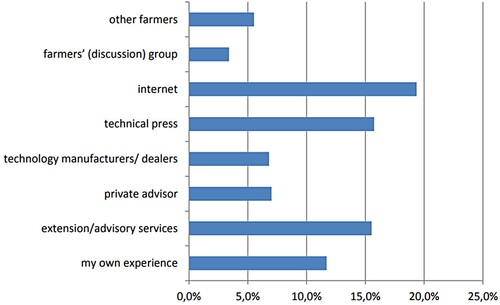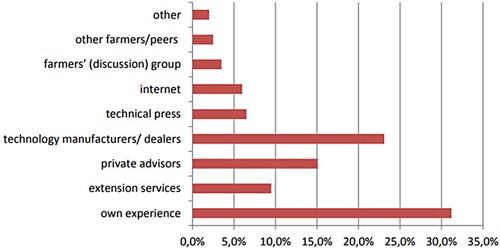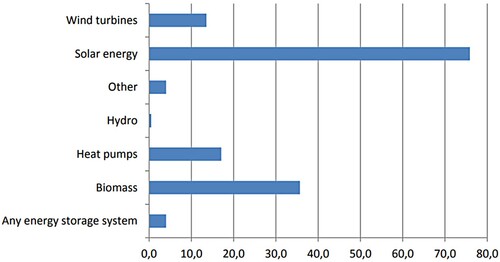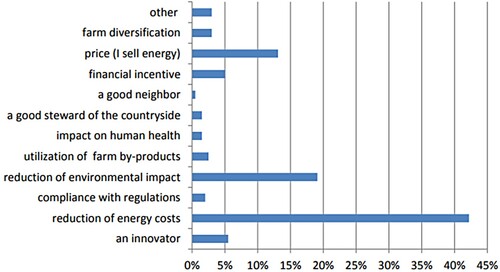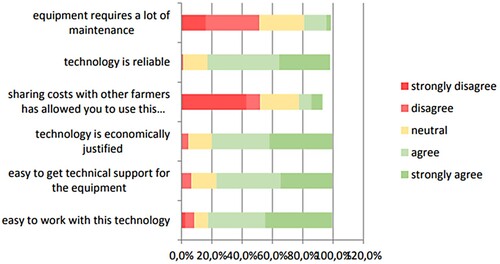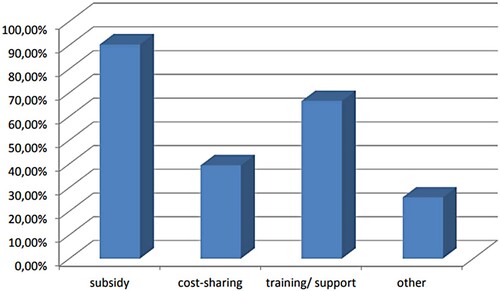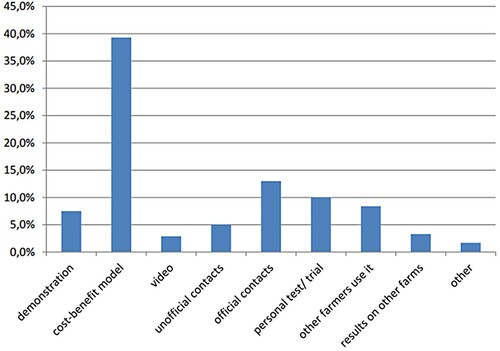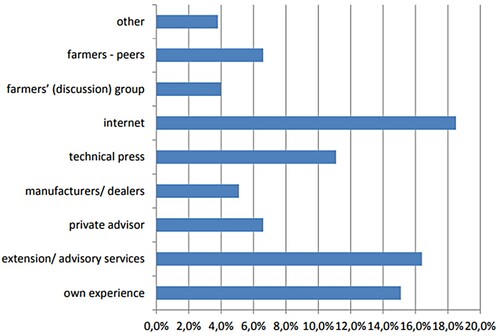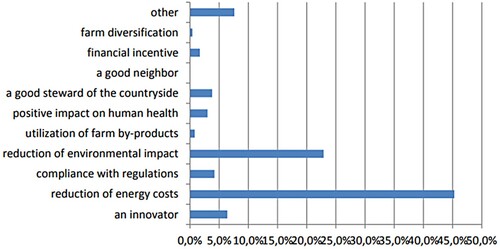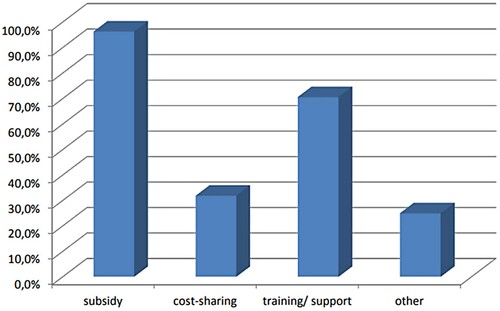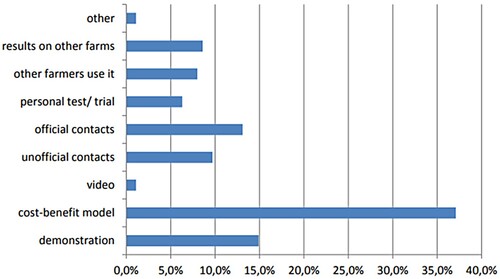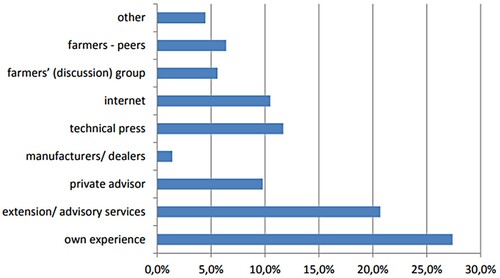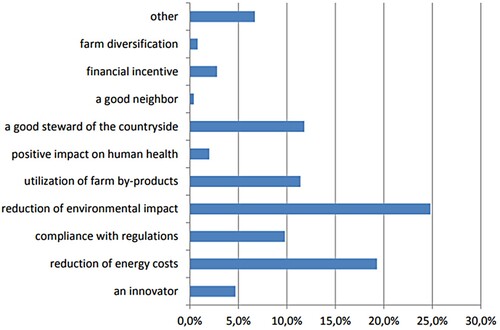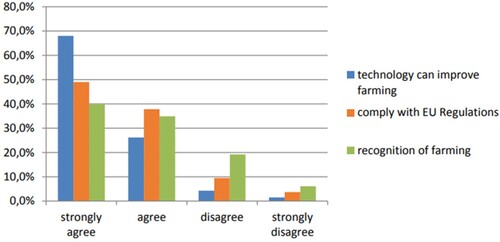ABSTRACT
This study investigates farmers’ needs, ideas and interests on the adoption of Fossil Energy Free Technologies and Strategies (FEFTS). 470 direct farmer surveys and 41 expert interviews were conducted in 8 EU countries to identify the barriers and drivers to the adoption of FEFTS, results were analysed using SPSS. The findings suggest that the adoption of FEFTS is driven primarily by economic factors, with cost reduction emerging as a dominant motivation for adopting renewable energy sources (RES) and energy-saving technologies/practices. Environmental concerns also play a significant role. Farmers indicate that financial support and access to tailored cost benefit models for their farms are important drivers to becoming FEFTS adopters. Based on these results we argue that enhanced financial support as planned in the Common Agricultural Policy 2023–2027 together with national advisory services that support innovation and knowledge transfer are necessary to drive the adoption of FEFTS in the agriculture sector.
1. Introduction
It is clear that energy use in agricultural production in the EU across the main production sectors is largely dependent on fossil energy sources (Paris et al. Citation2022a; Paris et al. Citation2022b; Paris et al. Citation2022c). Simultaneously it is increasingly recognised that for the EU agricultural sector to adapt to climatic change whilst contributing to environmental resilience and remaining competitive in the long run considerable transformations are needed across food systems (European Commission Citation2020). Such a transformation will require a shift in current farming practices and technologies away from fossil fuel dependencies through the adoption of Renewable Energy Sources (RES) and energy efficient technologies in farming. Simultaneously in recent years there have been many developments regarding RES and energy efficiency technologies and strategies and their methods of implementation making them more practical and economically viable for farmers. EU policy is now, through the Green Deal (European Commission Citation2022a), Farm to Fork (European Commission Citation2020) and the new CAP (European Commission Citation2022b), heavily focused on supporting such a green transition in the EU agriculture sector.
Farmer surveys are conducted regularly across the EU at various scales. In recent years some studies have investigated on the factors affecting adoption of new technologies in farming, notably precision agriculture and smart farming (related to the integration of information and communication technologies in agriculture [Bacco et al. Citation2019]). However, this research has largely been based on relatively small samples and are generally focused on one or few production systems, show geographic constraints and focus on a limited array of factors. A detailed investigation and analysis, based on primary evidence, of how farmers or groups of farmers see and approach these new technologies and strategies on an EU level is lacking.
In addition, in recent decades, the field of agricultural innovation has witnessed the emergence of various Systems of Innovation (SoI) approaches. These approaches highlight the multifaceted determinants influencing the development, diffusion, and utilisation of innovations. Particularly, the Agricultural Knowledge and Information Systems (AKIS) framework broadened the scope by incorporating actors beyond research, extension, and education, emphasising interactive learning processes. More recently, the concept of Agricultural Innovation Systems (AIS) has evolved, encompassing the interaction of actors involved in innovation. AIS emphasises the complex nature of the innovation process, focusing on learning, facilitation, and human interaction (Klerkx, Aarts, and Leeuwis Citation2010; Klerkx and Leeuwis Citation2008). In this context of the evolving nature of agricultural innovation farmers surveys and expert interviews are relevant as it captures their perspectives within the context of the intricate interactions and learning processes emphasised by AIS. Thereby contributing to our understanding of how farmers perceive, engage with, and adapt to innovations in the agricultural sector.
This paper aims to fill this gap by identifying farmers’ needs, innovative ideas and interests regarding FEFTS through a survey conducted among farmers as well as detailed interviews with selected advisory/extension services in 8 EU countries. The goal is to uncover the needs, ideas, and interests of farmers regarding FEFTS and understanding the drivers and barriers for FEFTS adoption. This is novel as it adopts a large scale and European approach focusing on identifying the drivers and barriers in the adoption of FEFTS among European farmers which has not been carried out before. Such knowledge can aid in the development of strategies for supporting sustainable transition across agricultural systems in the EU and aiding farmers in overcoming specific barriers to adopting FEFTS. These results are useful for policy makers as it can help in the design of evidenced policy-making that supports a green transition in EU agriculture.
1.1. Literature review on surveys for FEFTS adoption and technologies on farms
Eurostat and EU member states collect data on the structure of EU farms through surveys. This data provides detailed information of the status of agriculture in the EU covering farm and farmer characteristics, land, labour force, and support measures. Similarly, through national surveys, the farm accountancy data network (FADN) monitors the business activities and incomes of farms in the EU (European Commission Farm Accountancy Data Network Citation2022). These surveys provide a large amount of detailed information on farming; however, these surveys generally do not provide data or analysis on the drivers and barriers to the adoption of FEFTS or similar ‘Green’ transitions within the agricultural sector.
A range of smaller studies based on surveys do investigate the adoption of specific factors for a ‘Green’ transition in agriculture. A range of studies investigate the adoption of precision agriculture and energy efficiency technologies. Barnes et al. (Citation2019) investigate the adoption of precision agriculture in arable agriculture in five European countries from a sample size of 971 farmers (Barnes et al. Citation2019). Kernecker et al. (Citation2020) conducted surveys for farmers across the EU investigating farmers’ perception of smart farming technologies (Kernecker et al. Citation2020). Vecchio et al. (Citation2020) investigates factors affecting the adoption of precision agriculture in Italy (Vecchio et al. Citation2020). Lombardi and Berni (Citation2021) investigates the willingness of farmers to pay for a PV electric tractor (Lombardi and Berni Citation2021). Elahi, Khalid, and Zhang (Citation2022) investigate farmers’ willingness and intention to install renewable energy technologies in Pakistan. Tate, Mbzibain, and Ali (Citation2012a) compare different drivers in farmers adoption of RES in the UK finding that cognitive factors, such as education, were significant drivers while bureaucracy were not (Tate, Mbzibain, and Ali Citation2012b). These studies tend to focus on specific themes, such as factors affecting the adoption of smart farming or precision agriculture technologies, and are generally geographically limited to specific countries (Knierim et al. Citation2019).
Some studies have also investigated the interplay between various factors involved in technology adoption and diffusion within the agricultural sector. These studies highlight the role played by regulatory frameworks, cooperative mechanisms, and economic incentives as principal determinants influencing the adoption of technological innovations. However, these studies often focus on a limited array of determinants. These encompass an assortment of factors, including farmers’ age, educational background, technological proclivity (Tey and Brindal Citation2012; Paustian and Theuvsen Citation2017), attributes of the innovation itself and its compatibility with existing farming practices (Kutter et al. Citation2011), as well as farm-specific variables such as economic viability, engagement in full-time farming (Paustian and Theuvsen Citation2017), farm size (Kutter et al. Citation2011), and proximity to technology vendors (Reichardt and Jürgens Citation2009).
Various studies have been carried out over the past two decades that investigate behavioural and social factors that affect the adoption of sustainable farming practices (Dessart, Barreiro-Hurlé, and Van Bavel Citation2019). Studies have suggested that farmers are generally resistant to change and that change in their production processes is often seen as a loss (Burton, Kuczera, and Schwarz Citation2008; Samuelson and Zeckhauser Citation1988). For instance, Sheeder and Lynne find that farmers’ resistance to change prevents farmers from adopting conservation agriculture practices (Sheeder and Lynne Citation2011) while a recent study shows that a high percentage of farmers reject agri-environmental schemes (Barreiro-Hurlé, Espinosa-Goded, and Dupraz Citation2008). Another significant theme present in the literature suggests that European farmers are generally risk adverse and that in the context of economic various economic considerations and climate stress, the adoption of new practices and technologies is a risky undertaking (Hellerstein, Higgins, and Horowitz Citation2013).
Other studies highlight that technology adoption can be categorised into early, medium and late adopter groups and that there are significant differences between groups early adopters (Gardebroek Citation2006; Läpple and Rensburg Citation2011). For instance, Läpple and Van Rensburg find that early adopters are generally younger and less profit oriented while late adopters is associated with risk considerations (Läpple and Rensburg Citation2011). A review article on behavioural factors affecting the adoption of sustainable practices in farming published by the JRC highlights that the decision by farmers on whether to adopt more sustainable practices are not entirely rational from an economic point of view and that many other factors such as risk perception, environmental consideration, policy, personality, objectives, etc. also play a role. In this sense the paper highlights the importance of further understanding of behavioural factors impact on farmer decision and integrating it into policy making (Dessart, Barreiro-Hurlé, and Van Bavel Citation2019). Various articles investigate the importance of moral and environmental concern, finding that farmers with higher levels of environmental concerns are more likely to adopt sustainable practices and technologies (Michel-Guillou and Moser Citation2006; Best Citation2010; Toma and Mathijs Citation2007).
Regarding policy, Farmers’ responses to economic based policies vary. Saman investigates the effects on the ‘environmental performance’ of CAP payments finding that generally subsidies promote the use of renewable energy but that the impact is limited and varies geographically (Saman Citation2021). Another study finds that targeted studies do help improve the environmental sustainability of farmers but raise concerns over the economic efficiency of these subsidies (Bernini and Galli Citation2024).
It is worth highlighting that these investigations have some limitations. Notably, many of the studies are predicated upon empirical surveys, which may render them non-representative of the heterogeneity within the diverse farming landscape spanning various regions and countries. For instance, the inquiries conducted by Reichardt and Jürgens (Citation2009), draw exclusively from surveys administered at Agritechnica, Europe's preeminent Agricultural Technology Exhibition. This approach inherently skews the sample towards farmers actively seeking insights into agricultural technology, potentially introducing a selection bias. Additionally, certain studies exhibit limitations in terms of sample size or target audience. Noteworthy examples encompass the investigations by Kutter et al. (Citation2011) and Busse et al. (Citation2014), where the sample sizes tend to be relatively small, or the focus predominantly gravitates towards expert opinions.
In light of these limitations the present study is important as by investigating multiple themes and investigating the drivers and barriers on the adoption of FEFTS in the agricultural sector through a representative approach, this study aims to provide a more nuanced understanding of the determinants driving technology adoption and diffusion within the agricultural sector thereby aiding the development of strategies for supporting sustainable transition across agricultural systems in the EU and aiding farmers in overcoming specific barriers to adopting FEFTS.
2. Materials and methods
2.1. Conceptual framework
FEFTS broadly refer to technologies and strategies that reduce fossil energy dependencies and are related to sustainable energy production and use. Conceptually FEFTS were divided: into technologies and strategies that support the production of energy from RES on farm, technologies and strategies that: support improved on-farm energy efficiency, and other sustainable agricultural strategies, such as conservation or precision agriculture, that rationalise energy use and improve environmental resilience.
More specifically, based on an extensive literature review (Koutsouris and Vassilki Citation2020) conducted in the framework of the Horizon2020 project AgroFossilFree the RES on-farm energy production technologies are the following: solar (PV, PVT, thermal), wind turbine, biomass/biofuels/biogas, heat pumps (geothermal or aerothermal or hydrothermal), hydro, any energy storage system. While, energy efficiency/savings practices refer include, but are not limited to, efficient vehicles (biofuels or electricity fuelled, maintenance (e.g. tyre pressure), logistics/planning), efficient tools (pumps or drip systems for irrigation, conveyors, refrigerators, mills/grinders, dryers), precision agriculture (seed/fertilizer/pesticide/lime/manure/water reduction), conservation agriculture (crop rotation, intercropping, soil coverage, no/minimum tillage), efficient buildings (windows, BMS (building management system), lighting), precision indoor agriculture (seed/fertilizer/pesticide/lime/manure/water reduction). Adopters are defined as those that implement at least one of the above on their farms.
In order to provide a wide and inclusive view of the EU agricultural sector farms were divided into categories based on production specialisation: open-field, livestock and greenhouse production. This approach was chosen as it allowed specialised insights into different sectors and informed by the FADN.
2.2. Survey and interview structure
The objective of this study is to account for and capture the different needs and priorities of farmers regarding the adoption or non-adoption of FEFTS in relation to their different socio-economic characteristics.
The goal of the survey was to get a detailed insight into farmers’ perception on farmer’s needs, ideas and interests on the adoption of FEFTS. The development of the survey, the sampling structure and the conducting of the survey and expert interviews went through multi-stage process. The development of the survey was based on a conceptual framework determined through an extensive literature review and supported by the main theories and research findings concerning the generation, adoption and diffusion of energy related technological innovations and best practices (Koutsouris and Vassilki Citation2020). This process conducted an extensive investigation into innovation processes in agriculture, their diffusion and adoption with a focus on renewable Energy sources, energy efficiency in agriculture and conservation agriculture.
This review, providing an understanding on farmers’ innovation-related decision-making, including the key-factors, such as farmers’ and farms’ characteristics, biophysical, socio-cultural and institutional environment, which influence the process of adoption, that is, if and how innovations are adopted (Koutsouris and Vassilki Citation2020). This was followed by a detailed review of each technological system. Based on this a survey (farmers’ questionnaire) and experts interview guide was developed (see Annex). The process of formulating the questions were centred around various co-generation processes around a multi-actor approach with the AgroFossilFree consortium which brought together a mix of research organisations, policy makers, farmers, innovation brokers, farmers and extension services. Based on the literature review an effort was made to address as many factors (multifactorial approach) as possible while taking into account the number of themes to be addressed, farmers’ time constraints and the project’s resources.
The survey was split into various sections, the first section centred around questions that determine the characteristics of the farmer and farm, questions focused on their awareness and use of RES, based on their answers to these questions farmers were either identified as adopters or non-adopters of RES. A FEFTS adopter is a farmer who depending on the category either uses RES and/or energy efficiency technologies and practices. If they were classified as adopters, they were then asked a series of questions based around their processes for adopting RES, their, and their evaluation of RES technologies. This process was repeated for energy saving practices and ideas and carbon sequestration practices. This was then followed by a range of questions attempting to determine farmer’s attitudes regarding information on innovations and farmers’ general opinion about technology. This survey was structured into three sections as it allowed for an in-depth analysis into each section. It was also important to determine farm and farmer characteristics to see if these had an impact on the adoption or non-adoption of FEFTS (see Annex for the full survey).
Regarding the expert’s interview guide, these were mainly targeted at advisors. The objectives were similar to the survey with a focus on identifying the main factors supporting or hindering the adoption of FEFTS, what farmer characteristics may be significant. In addition, a number of the questions were centred around policy and identifying the role and potentials of policy in driving the adoption of FEFTS.
2.3. Sampling structure
In consideration of the farmers’ survey, our approach, guided by the review, posits that selecting farmers based on their farm size provides a diverse representation of farming scenarios. This method allows for a comprehensive exploration of the adoption or non-adoption patterns regarding Renewable Energy sources, energy efficiency, and carbon sequestration technologies. Moreover, it facilitates an in-depth investigation into the role of innovation support systems, including advisory and extension services, along with training opportunities. The analysis also delves into the influence of policy dynamics, environmental constraints, and the sociocultural and economic contexts of the farmers. This comprehensive strategy aims to unveil a nuanced understanding of the myriad factors influencing farmers’ engagement with these technologies and practices.
Our study covered 8 different European countries: Denmark, Germany, Greece, Italy, Ireland, The Netherlands, Poland, and Spain. As our objective was to account and capture the different needs and priorities of FEFTS adoption for farmers in relation to their different socio-economic characteristics we considered that about half our sample needed to be adopters and the other half non-adopters. While in order to ensure that we had a representative sample of adopters but also of farmers in the EU we considered it necessary to conduct at least 50 surveys per country and also based on the contribution (%) in terms of utilised agricultural area (UAA) or Livestock Units (LU) in each country, a first estimation of the sample (no. of farms/farmers per farm size per country) was made based on the Eurostat 2013 data set. This process allowed for the development of a representative sample split between plant and livestock farms. Both adopters and non-adopters are included in the sample with a goal of surveying around 50% FEFTS adopters and ca 50% non-adopters per country.
Based on this the final sample size was 470 farmers and comprises farmers with all kinds of production systems (crop production, animal production and mixed production). The sample farmers are mainly men (87%); between 40 and 59 years old (61%); with good educational level (secondary 19% and technical 52%).
2.4. Data collection and analysis
The surveys and expert interviews were conducted by the relevant partners in each country of the H2020 AgroFossilFree project. The survey was conducted by each partner either in person or telephonically directly with the farmer. Data was entered into an Excel form and analyzed using SPSS 23. SPSS was employed for univariate and bivariate data analysis regarding data collected via the farmers’ survey. In the paper, some of the results of the univariate analysis are presented in the form of tables, and statistical significance is indicated where possible. In total, 470 surveys were successfully completed (). Similarly, expert interviews were conducted, and in total, 41 experts were interviewed ().
Table 1. Farmers’ survey sampling per production system.
Table 2. Composition of the experts interviews.
2.5. Limitations
The methodology employed to differentiate between adopters and non-adopters relied on survey participants’ self-identification, a decision made after careful consideration. While this approach was selected as the most suitable within the study's scope, it's important to acknowledge that this method introduces an inherent element of subjectivity, potentially leading to varied interpretations among participants. Therefore, while informative, the results should be approached with a degree of caution.
Undertaking surveys and interviews during the Summer of 2021 occurred against the backdrop of the ongoing COVID-19 pandemic. The implications of this global situation were far-reaching, introducing logistical complexities that affected the ability to conduct in-person interviews and surveys. The resultant limitations in direct interpersonal engagement may have influenced the depth and nuance of responses obtained, warranting acknowledgment when interpreting the study's outcomes.
The considerable number of surveys and expert interviews conducted yielded statistically significant findings, reinforcing the validity of the study's outcomes. However, it's crucial to contextualise these outcomes within the vast and diverse landscape of the European Union's agricultural sector. The multifaceted nature of farming systems and holdings across different regions introduces variability that a larger sample size could address. Expanding the scope of future research to encompass a more extensive participant pool is advised, as this step holds the potential to bolster the robustness of conclusions and their applicability across a broader range of contexts.
This study's insights serve as a foundation for future research into the identified themes. As the field continues to evolve, it is essential to recognise the value of integrating these inquiries into established farm survey structures. To ensure the accuracy and generalizability of findings, larger-scale surveys are recommended in subsequent investigations. By doing so, researchers can enhance the precision of their analyses, providing a more comprehensive understanding of the intricate dynamics at play within the agricultural sector.
3. Results
The survey and expert interviews brought together a large number of findings and insights, the main findings are presented here, for more detailed information, including country specific data, please refer to our data availability statement (Koutsouris and Kanaki Citation2021).
3.1. Characteristics of farmers and their correlation with the adoption of FEFTS
Our findings show some notable differences between the characteristics of adopters and non-adopters of FEFTS. Adopters are often those who work as full-time farmers, having chosen agriculture as their primary profession. They tend to rely more heavily on farming for economic sustenance, with agriculture contributing a significant share to their household income. These adopters express a higher level of satisfaction with their farming endeavours and actively participate in diverse on-farm activities, certification programs, and CAP Pillar II projects. Furthermore, adopters display a greater tendency to attend agricultural fairs, field days, demonstrations, or exhibitions compared to non-adopters. It's noteworthy that adopters and non-adopters prioritise different sources of awareness. While there are similarities in characteristics between the two groups, both within various categories and across geographical locations, distinctions exist in their preferences and engagement levels.
Our findings reveal that adopters assign less significance to the evaluation of characteristics in RES that would enhance their relevance to farmers’ needs compared to non-adopters. While adopters may not exhibit stronger beliefs in the potential and utility of technology, they demonstrate a greater inclination towards experimentation on their farms. Additionally, adopters are more prone to being pioneers in their social circles, being among the first to be aware of and acquire new machinery or technology. They display a willingness to invest in innovative solutions despite potential negativity from their social environment and are more predisposed to taking risks.
3.2. Renewable energy sources
Our findings indicate a widespread awareness of RES among farmers, with less than 7% of respondents stating that they are unfamiliar with RES. Solar energy (94%) and biomass (89%) emerge as the most recognised types of RES, closely followed by wind turbines (84%) and heat pumps (78%). provides a breakdown of farmers’ awareness of RES per country. The primary sources of information for farmers regarding RES, as reported by over 15% of respondents, include the Internet, technical publications, and national or regional agricultural extension/advisory services provided by public or cooperative entities.
Table 3. Farmers’ awareness of RES (%) per country.
3.2.1. RES adopters
In the overall survey, approximately 45% of respondents identified themselves as adopters, indicating the use of (RES) on their farms. Among RES adopters, about two-thirds mentioned having witnessed demonstrations or tested the technology before acquiring or purchasing it. Regarding the primary sources of knowledge and awareness on RES for farmers, the Internet ranked highest at 19.4%, followed by the technical press at 15.7%, and national or regional agricultural extension/advisory services (public or cooperative) at 15.5%. Additionally, farmers noted their own experiences as a significant source, accounting for 11.7% ().
The primary source of information and support for farmers regarding the establishment and utilisation of Renewable Energy Systems (RES) is their own experience, constituting 31.2%. This is followed by manufacturers/dealers at 23.1% and private advisors at 15.1% ().
Solar is the most extensively adopted RES, embraced by 76% of RES adopters and users. Followed by biomass/biofuels/biogas at 36%, along with heat pumps and wind turbines, as depicted in .
Economic considerations, particularly the prospect of reducing energy costs, emerged as the primary motivator for the adoption of Renewable Energy Systems (RES), accounting for 42.2%. Environmental concerns also played a substantial role, motivating 19.1% of respondents, with variations noted among countries (). Additionally, over two-thirds of adopters acknowledged that a specific subsidy played a pivotal role in facilitating their investment in RES on their farms. In general, adopters expressed favourable views, stating that RES are user-friendly (82%), dependable (81%), and economically justified (79%) (). When it comes to maintenance and, when necessary, repairs of RES, farmers primarily rely on manufacturers/retailers (79%), their own experience (58%), and independent service providers (49%). The study highlighted that the predominant uses of energy generated from RES included heating and cooling of buildings (72.3%) and lighting (66.1%). Moreover, a noteworthy proportion of farmers engaged in selling excess energy to external consumers, accounting for 61.9%.
3.2.2. Non adopters of RES
Non-adopters cite financial constraints as the primary impediment to having RES on their farms, with 40% expressing an inability to afford the technology. An additional 19% attribute their non-adoption to the consideration that the available technology is either not the most suitable for their needs or is incompatible with existing machinery and equipment on their farms, as illustrated in . Moreover, non-adopters emphasise their willingness to embrace RES if provided with a subsidy, with 90% expressing this. Additionally, 66% state that relevant training would motivate them to adopt RES ().
These farmers identify a cost–benefit model customised to their farm as the most crucial source of information they would trust before deciding to adopt or use RES technology, accounting for 39.3%. Official contacts, such as advisors, officials, or individuals paid for their services, are deemed trustworthy by 13% of respondents, followed by personal trials, which are cited by 10% ().
3.2.3. Adopters vs. non-adopters of RES
In examining the factors influencing farmers’ decisions regarding the adoption of Renewable Energy Sources (RES), notable distinctions emerge between adopters and non-adopters. The sources of knowledge deemed most important vary significantly between the two groups (p < 0.05), indicating a statistically significant difference. Adopters tend to rely more on ‘own experience,’ ‘private advisors,’ and ‘industry/technology manufacturers,’ while non-adopters lean towards ‘Internet,’ ‘technical press,’ and ‘peers.’ This highlights the divergent information channels shaping their understanding of RES.
Furthermore, the characteristics that adopters prioritise in RES technologies differ significantly from non-adopters. Adopters place less emphasis on ease-of-use and installation (p = 0.000, p < 0.010, respectively), immediate economic benefits (p < 0.05), the reduction of environmental hazards (p < 0.010), reasonable acquisition prices/affordability (p < 0.10), technical support (p = 0.000), compatibility with existing farm machinery/equipment (p < 0.10), and operator safety (p = 0.000). These findings underscore the nuanced considerations that influence the adoption of RES technologies.
Interestingly, while adopters and non-adopters share similar beliefs about the capability of RES technology to improve farming and assist in regulatory compliance, adopters exhibit distinct behaviours. Adopters are more inclined to experiment with new technologies or practices on their farms before committing to full-scale adoption (p < 0.010). They also display a greater readiness to be the first in their social circles to know about and purchase new machinery/technology (p < 0.010, p = 0.000), indicating a proclivity for early adoption.
Moreover, adopters demonstrate a higher tolerance for risk in farming (p < 0.05), as opposed to non-adopters who are more cautious and likely to wait until they witness positive experiences in their social circles before making new purchases (p = 0.000). Non-adopters also prefer having prior experience with a technology before making a purchase (p < 0.010). This multifaceted analysis provides valuable insights into the complex interplay of beliefs, behaviours, and preferences that contribute to the adoption or non-adoption of RES among farmers. Understanding these factors is crucial for designing targeted interventions and policies that resonate with farmers’ unique perspectives and decision-making processes.
3.3. Energy saving technologies and practices
Inquired about their awareness of various indicative energy-saving technologies and practices, sample farmers provided insights. For those managing open-field farms, a significant proportion indicated awareness of conservation (85.2%) and precision agriculture (84.2%), along with familiarity with energy-efficient tools (78.1%) and vehicles (76.7%) (). Greenhouse farmers reported awareness of energy-efficient tools and buildings at 82.9% and 81%, respectively, as well as (indoors) precision agriculture (75.6%) and efficient vehicles (75%). Livestock farmers affirmed their awareness of efficient buildings (83%), energy-efficient tools (77.4%), precision livestock (74.3%), and to a slightly lesser extent, efficient vehicles (69.4%). In total, 84.3% of the sample farmers indicated awareness of at least one energy-efficient technology and/or practice. Notably, awareness levels were highest in The Netherlands (98.2%), Italy (96.8%), Greece (95.2%), and Denmark (94.2%).
3.3.1. Adopters of energy saving technologies and practices
Among those who are aware of energy-saving technologies and practices, 60% claimed to have adopted these measures on their farms. For open-field farms, the predominant adoptions include conservation (37.8%) and precision agriculture (30.1%), followed by energy-efficient tools (28.4%) and vehicles (20.7%). Greenhouse-oriented farmers reported higher adoption rates for efficient buildings (9.3%), precision agriculture (7.6%), and energy-efficient tools (7.2%), while efficient vehicles were used to a lesser extent (1.2%). In livestock farming, the majority adopted efficient buildings (35.2%), followed by efficient tools (28.9%) and precision livestock (19.6%), with efficient vehicles being less commonly utilised (5.9%). Notably, a substantial portion of adopters (58.5%) had either witnessed demonstrations or tested the energy-saving technology or practice before making a purchase or implementation.
Regarding the primary source of knowledge and awareness for farmers concerning energy-efficient technologies and practices, respondents indicated a reliance on various channels. The Internet emerged as the most crucial source at 18.5%, followed by national or regional agricultural extension/advisory services (public, cooperative) at 16.4%. Farmers also highlighted their own experiences as a significant source, accounting for 15.1%, with the technical press contributing at 11.1% ().
The farmers’ primary source of information and support regarding the establishment and use of energy-efficient technologies and practices is derived from their own experiences, constituting 31.4%. Following this, manufacturers/dealers play a significant role, with 21.2%, and national or regional agricultural extension services (public, cooperative) contribute at 13.6% ().
Figure 10. Most important source of information/support for energy efficient technologies/practices’ establishment and use.

Economic factors, specifically the reduction of energy costs, were identified as the primary motivation for adopters of energy-saving technologies/practices, with 45% citing this as their main driver. Following closely, 23% of adopters expressed a motivation to reduce the environmental impact of their practices. Interestingly, only one-third of adopters mentioned that a specific subsidy played a role in facilitating their investment in such technologies/practices on their farm ().
Overall, adopters express positive sentiments about energy-efficient technologies/practices, with 84.9% considering them reliable, 82.1% finding them easy to work with, and 80.9% deeming them economically justified. Moreover, according to the feedback from interviewed adopters, acquiring technical support for their equipment is perceived as straightforward by 71.3% ().
3.3.2. Non-adopters of energy saving technologies and practices
Non-adopters attribute their lack of utilisation of energy-efficient technologies/practices on their farms primarily to financial constraints, with 26.9% stating that they cannot afford such technologies. Additionally, 17.1% express concerns about the unavailability of the best-fitting technology tailored to their situation/production system, and 5.1% find the available technology incompatible with their existing machinery and equipment. The relatively small farm size is also cited as a reason by 13.1% ().
Approximately two-thirds of non-adopters express their willingness to use energy-efficient technologies/practices if they were to receive a subsidy (96%) or relevant training (71%) (). These non-adopters identify a cost–benefit model tailored to their farm as the most important source of information they would trust before deciding to adopt/use energy-efficient technologies/practices (37.1%). Demonstrations are considered significant by 14.9%, and official contacts, including advisors, officials, or individuals paid for their services, are trusted by 13.1% ().
3.3.3. Adopters vs. non-adopters of energy-efficiency technologies/ practices
Our findings, marked by statistical significance (p < 0.05), illuminate distinct preferences in information sources between adopters and non-adopters. Adopters exhibit a preference for ‘technical press’ and ‘farmers’ groups,’ emphasising these avenues for acquiring knowledge, while non-adopters gravitate towards ‘own experience,’ ‘Internet,’ and insights from ‘other farmers.’ This diversity in information channels underscores the need for tailored communication strategies to bridge the gap between adopters and non-adopters.
Turning our attention to the characteristics that render energy-saving technologies relevant to farmers, we identify notable differences. Adopters place less emphasis on ease-of-use and installation (p < 0.05, p < 0.05), immediate economic benefits, environmental impact, affordability, technical support, compatibility with existing machinery, long-term reliability, and operator safety (p < 0.10, p = 0.000). These nuanced distinctions highlight the multifaceted considerations influencing adoption decisions.
Regarding the beliefs and attitudes of adopters versus non-adopters, adopters express stronger convictions in the technology's capability to enhance farming practices (p = 0.000) and assist in regulatory compliance (p < 0.05). Additionally, adopters exhibit a more adventurous spirit, as evidenced by their inclination to experiment on their farms before full-scale adoption (p = 0.001). Their willingness to be early adopters within their social circles (p = 0.000, p = 0.000) and their lack of fear in taking risks in farming (p < 0.05) set them apart from non-adopters. Conversely, non-adopters display a more cautious approach, waiting until they observe positive experiences from others before embracing new technologies (p = 0.000).
Finally, the link between adopters of energy efficiency technologies/practices and Renewable Energy Source (RES) adoption unveils a significant connection (p = 0.000). This suggests a potential domino effect, where positive experiences with one type of technology may catalyze openness to other sustainable practices. These nuanced findings provide a comprehensive understanding of the factors shaping farmers’ adoption decisions and offer valuable insights for tailoring strategies to promote the acceptance of energy-saving technologies within the farming community.
3.4. Soil carbon sequestration practices
3.4.1. Adopters of soil carbon sequestration practices
The survey briefly addressed issues related to carbon sequestration. A significant majority of farmers (>88%) reported being aware of relevant practices such as manuring and fertilising, cover crops and crop rotations, conservation tillage, and crop residue management (each >88%). The most crucial sources of information and awareness for farmers regarding carbon sequestration practices, each acknowledged by more than 10% of farmers, include their own experiences, national or regional agricultural (public, cooperative) extension services, technical press, and the Internet (). More than three-quarters of the interviewees (approximately 77%) stated that they employ such practices on their farms. Their primary motivations, noted by over 19% of farmers, include the desire to reduce the environmental impact of farming, lower energy costs, act as responsible stewards of the countryside, and utilise farm by-products.
Farmers cite several motivations for adopting carbon sequestration practices, with the reduction of the environmental impact of farming being the most significant at 24.8%. This is followed by the desire to reduce energy costs (19.3%), a commitment to ‘being a good steward of the countryside’ (11.8%), the utilisation of farm by-products (11.4%), and compliance with regulations (9.8%) (). On a country level, in all countries over 15% of farmers are primarily motivated to reduce energy costs. This motivation is notably strong in The Netherlands (35.5%) and Denmark (23.8%). Environmental concerns, focused on decreasing the environmental impact of farming, were cited by at least 10% of farmers in each country, except for Greece and Denmark, where the percentages are 7.4% and 4.8%, respectively.
3.4.2. Non adopters of soil carbon sequestration practices
Farmers assert that the primary reason for not adopting carbon sequestration practices is the absence of appropriate or best-fitting technologies/practices, cited by 44.7%. Other reasons include the constraint of a small farm size (19.7%) and the inability to afford the adoption of such practices (10.5%) ().
3.4.3. Adopters vs. non-adopters of carbon sequestration practices
Surprisingly, adopters and non-adopters don't differ significantly in their belief about technology's ability to enhance farming or assist with regulations. However, a distinct finding emerges – adopters strongly believe that technology plays a role in gaining public recognition for farmers’ hard work (p < 0.010), indicating a unique perspective that sets them apart.
Adopters exhibit an adventurous spirit by being more willing to experiment with new technologies on their farms before committing to full-scale adoption (p < 0.05). They also tend to be trendsetters, being the first in their social circles to learn about new technology (p < 0.010). Interestingly, this eagerness doesn't always translate into immediate purchases – there's no significant difference in their likelihood to be the first to buy. In contrast, non-adopters prefer a more cautious approach, waiting until they hear positive experiences from others before embracing new technologies (p = 0.005). They also express a preference for personal experience before making a purchase (p = 0.005).
Surprisingly, when it comes to risk-taking in their farming businesses and considering the opinions of their social environment regarding technology adoption, adopters and non-adopters don't show significant differences. This implies a shared approach to risk and social influence considerations within the context of adopting new technologies or practices.
Lastly, a notable discovery relates to adopters of carbon sequestration practices. These individuals are significantly more likely to also adopt Renewable Energy Sources (RES) and energy efficiency technologies/practices (p = 0.000 in both cases). This interconnected adoption pattern suggests potential synergies between different sustainable farming practices. These nuanced findings provide a comprehensive understanding of the beliefs and behaviours surrounding technology adoption within the farming community, offering valuable insights for designing targeted interventions and fostering widespread acceptance of innovative agricultural technologies.
3.5. Innovation and technology
According to interviewed farmers, the most critical characteristics for RES and energy-efficiency technologies/practices to be relevant to their needs include long-term reliability, price/affordability, ease of use, operator safety, and compatibility with existing farm machinery, with each attribute receiving support from over 80% of farmers (). Technology, as perceived by the interviewees, is seen as contributing significantly to the improvement of farming (94%), assisting farmers in complying with EU Regulations (87%), and supporting the recognition of their work by the wider public (75%). In tandem, a majority of interviewed farmers (70%) claim to engage in experimentation on their farms, trying new technology or practices before adopting them at a full scale. Additionally, almost two-thirds of farmers express a preference for having some experience with a technology or practice before making a purchase, while more than half state that they wait to buy new things until they are aware of others having positive experiences with them. Despite this cautious approach, a majority of farmers are neither the first to know about new technology in their social circles nor the first to buy it. Most farmers express a reluctance to take risks with their farming business (41%). Nevertheless, just over 50% would be willing to buy new equipment even if their social environment held a negative view of it.
3.6. Expert insights
Insights from interviews with experts, primarily advisors, underscore a consensus in favour of RES and energy-saving technologies/practices as viable solutions to address the contemporary challenges facing agriculture. These experts affirm that the adoption of such technologies and practices offers tangible benefits to farmers, encompassing economic viability and environmental sustainability, while simultaneously enhancing the public perception of the agricultural sector. Additionally, these innovations contribute to farm diversification and stimulate employment opportunities in rural areas.
According to the experts for the successful integration of RES and energy-saving practices into agriculture, it becomes evident that a specific blend of policies is essential. These policies should emphasise long-term stability, ensuring consistency to alleviate farmer insecurities stemming from frequent changes. Financial incentives are a pivotal component, enabling investments to yield profitability. Furthermore, these policies should facilitate the dissemination of reliable information, including extension and advisory services, as well as educational and training programs tailored to the needs of farmers. The elimination of cumbersome bureaucratic processes is strongly recommended to streamline adoption.
Notably, the current policy landscape exhibits certain shortcomings, as certain non-sustainable practices persist within farming due to inadequacies in supporting or penalising energy-related behaviours. Experts emphasise that, while environmental and societal pressures carry weight, the primary impetus for farmers to embrace RES and energy-saving technologies/practices remains economic, driven by reduced energy costs and potential energy sales. Conversely, experts acknowledge significant challenges associated with RES adoption, such as substantial upfront investment costs and potentially protracted returns on investment, depending on the chosen technology. This underscores the consensus among experts and farmers alike regarding the critical need for financial support, especially for small and medium-sized farmers.
Moreover, experts identify similarities between adopters and non-adopters, as observed in the preceding survey analysis. They also emphasise the necessity for ongoing development of RES and energy-saving technologies, despite their current market availability.
While recognising the pivotal roles of research and advisory services in this domain, experts state that farmers are often positioned as passive consumers rather than active participants in shaping the industry's products and solutions. Additionally, it is noted that, in many countries represented in this study, farmers are inadequately integrated into the national Agricultural Knowledge and Innovation Systems (AKIS), with a few exceptions where farmer representatives advocate for pertinent legislation. The absence of functional AKIS or innovation platforms specific to RES and energy-efficient technologies/practices remains a noteworthy issue.
4. Discussion
The findings presented in this study shed light on the characteristics of farmers and their correlation with the adoption of Renewable Energy Sources (RES), energy-saving technologies/practices, and carbon sequestration practices within the context of the AgroFossilFree project. These insights provide valuable implications for the promotion and implementation of sustainable agricultural practices. This discussion section will analyze and interpret the key results, their implications, and their alignment with existing literature.
4.1. Characteristics of farmers and adoption of FEFTS
The analysis of farmers’ characteristics in relation to the adoption of FEFTS revealed several notable trends. Adopters of FEFTS exhibit a distinct profile, being more likely to engage in full-time farming, have a stronger economic dependence on agriculture, engage in diverse on-farm activities, and actively participate in certification schemes and CAP Pillar II projects. This aligns with prior research suggesting that farmers with a stronger commitment to agriculture are more open to incorporating innovative technologies (Paustian and Theuvsen Citation2017).
Furthermore, adopters’ willingness to explore new machinery and technology, even in the face of negative social attitudes, highlights their innovative mindset and willingness to take risks. This finding is consistent with studies emphasising the importance of risk-taking behaviour in agricultural innovation adoption (Sauer and Zilberman Citation2012).
However, it's noteworthy that adopters do not place as much emphasis on the perceived importance of RES characteristics compared to non-adopters. This suggests that adopters might prioritise their practical experiences and outcomes over theoretical attributes when making adoption decisions.
4.2. Renewable energy sources
The high awareness of RES among farmers, with solar and biomass being the most recognised types, reflects the increasing prominence of these technologies in the agricultural sector. The predominant use of solar energy resonates with their cost-effectiveness and ease of implementation. The positive perceptions of adopters regarding RES reliability, ease of use, and economic justification are in line with previous studies that highlight these factors as key drivers of adoption (Li et al. Citation2021; Wang et al. Citation2020). As solar costs continue to decrease and is relatively easy to install it is likely that the dominance of solar sources will continue in the medium term.
On an EU level, economic motivations emerge as primary reasons for RES adoption, followed by environmental concerns. The influence of subsidies on adoption is evident, indicating the role of policy support in driving sustainable practices. This corresponds to literature emphasising the significance of policy incentives, especially financial ones, in promoting renewable energy adoption (Elahi, Khalid, and Zhang Citation2022; Banks, Salter, and Chesshire Citation2007; Brudermann et al. Citation2013). Conversely the most important reason for not adopting RES is also economic, related to non-affordability, which is inline with findings by other studies that cite the high upfront cost of adopting RES technologies (Tate, Mbzibain, and Ali Citation2012a; Elahi, Khalid, and Zhang Citation2022; Majeed et al. Citation2023). Considering both these points this suggests that RES adoption makes financial sense in certain contexts but not in others. What these contexts are could be an important area for future research. In addition, it is important to note that this study was conducted before the war in Ukraine, it is reasonable to assume that the subsequent increase in energy costs in the EU, particularly fossil fuels, have made the economic dimension even more important and been an added incentive for adoption of RES as well as energy saving technologies and practices.
The most important sources of information/support for RES establishment and use are technology manufactures/dealers, private advisors and own experience while public extension services are relied on to a considerably lesser degree. This is important as it illustrates that links between manufactures and dealers as well targeted extension services that support the adoption, use and maintenance of RES have an important role to play in driving adoption.
The farmers declared that the most important source of information they would trust before deciding to adopt/use RES technology are a cost–benefit model tailored to their farm. This is in line with other findings that adopting new technology is a ‘risk’ for farmers (Iyer et al. Citation2020) and that evidence on the costs against benefits could help farmers adopt, this is also corroborated by the expert interviews.
4.3. Energy-saving technologies and practices
Similar to RES, energy-saving technologies/practices have garnered substantial attention among farmers. The adoption patterns, motivations, and information sources for energy-saving technologies closely resemble those for RES. The reliance on farmers’ own experience and peer-based learning reflects the significance of experiential knowledge in driving adoption decisions.
The economic rationale for adopting energy-saving technologies aligns with the broader agricultural goal of cost reduction while cost is also the main barrier to the adoption of these technologies and practices (Barnes et al. Citation2019). The relatively low importance of subsidies for adopters contrasts with the substantial importance attached to subsidies by non-adopters. This indicates a need for targeted policy interventions to bridge this gap and promote wider adoption.
In general, the vast majority adopters state that energy efficient technologies/practices are reliable, easy to work with and economically justified. While non-adopters state that cost is the main barrier and would like to see a tailored cost benefit model prior to adoption. Both these points suggests that non-adopters could become adopters if they have some level of financial support combined with extension services that provide a cost–benefit model. Another issue is that farmers indicate that the ‘best fitting technology’ does not exist, this suggests that developing increased links between manufactures and farmers could be beneficial.
4.4. Soil carbon sequestration practices
The recognition of carbon sequestration practices among farmers underscores a growing awareness of environmental sustainability. The motivation for adopting these practices is primarily driven by environmental considerations, energy cost reduction, and the desire to be responsible stewards of the land. The substantial adoption of these practices without specific external subsidies highlights farmers’ intrinsic motivation for sustainable land management.
For non-adopters, barriers to carbon sequestration practices are tied to technology availability, affordability, and farm size. These findings emphasise the importance of tailoring strategies to address the specific concerns of non-adopters, especially those related to technological suitability and financial feasibility. Here the role of education and extension services appear relevant as other studies have documented that farmers seek evidence of the benefits of soil carbon sequestration techniques supported by policy incentives (Mills et al. Citation2020 ; Payen et al. Citation2023).
4.5. Innovation and technology
Farmers’ perspectives on technology and innovation provide valuable insights into their attitudes and decision-making processes. The emphasis on attributes like long-term reliability, affordability, and compatibility with existing machinery aligns with prior research highlighting practical and pragmatic considerations in technology adoption (Caffaro et al. Citation2020). The majority of farmers’ willingness to experiment with new technologies on their farms signifies a culture of learning and adaptation. However, risk aversion remains a significant factor, with more farmers indicating a reluctance to take risks in their farming business. This highlights the need for supportive environments that encourage innovation while addressing concerns related to risk.
4.6. Information sources
One notable finding across all three domains is the significant variance in information sources between adopters and non-adopters. The reliance on ‘own experience,’ ‘private advisors,’ and ‘industry/technology manufacturers’ by adopters of RES highlights the importance of personal knowledge and expert guidance in shaping their decisions. In contrast, non-adopters’ preference for ‘Internet,’ ‘technical press,’ and ‘peers’ underlines the role of external information and social networks in influencing their perceptions. This aligns with previous research emphasising the impact of social networks on technology adoption decisions (Ramirez Citation2013).
4.7. Implications for policy and future research
The findings from this study have significant implications for policy-makers and practitioners aiming to promote sustainable agricultural practices. The identification of key characteristics associated with adoption provides a basis for targeted outreach and support. Policy interventions should focus on aligning incentives, such as subsidies and tailored training programs, with the motivations and concerns of both adopters and non-adopters. Our results also suggest that extension services that provide detailed information on RES and energy saving technologies and practices, in particular that integrate cost–benefit models can support the adoption of FEFTS. The role of extension services here is important as it can also be a mechanism to improve the integration of farmers into AKIS, a key recommendation from the expert interviews. In practice this is a complex task as there are considerable variations in the breadth and depth of available advisory services across EU member states. Considerable efforts have been made to make advisory systems more supportive of ‘innovation and knowledge’ flows however their impact is still debated and further efforts need to be made to reach ‘hard to reach farmers’ with relevant funding opportunities but also the design of services that fit their needs (Labarthe and Beck Citation2022).
In practice the CAP 2023–2027 provides considerable amounts of funding for sustainable transitions within the EU agricultural sector (European Commission Citation2022c). These are likely to help a large number of farmers to transition from non-adopters to adopters of FEFTS and help overcome the main barriers to the adoption of FEFTS. Tracking the effectiveness of these measures and ensuring that they are tailored to the diversity of farmers is a crucial part of research in the short and medium term. However, a critical examination of the previous CAP's impact reveals a mixed record in achieving environmental objectives. This underscores the complexity of factors influencing farmers’ decisions, indicating that economic incentives alone may not guarantee widespread adoption of sustainable practices (Dessart, Barreiro-Hurlé, and Van Bavel Citation2019).
The connection between adopters of carbon sequestration practices and their likelihood to also adopt RES and energy-saving technologies/practices unveils a potential domino effect within the farming community. Positive experiences with one type of sustainable technology may serve as a catalyst for openness to adopting others. This interconnected adoption pattern suggests that holistic approaches addressing multiple sustainable practices could amplify the impact of interventions.
This study provides a comprehensive understanding of the factors influencing the adoption of FEFTS, RES, energy-saving technologies/practices, and carbon sequestration practices. However, future research could delve deeper into the socio-economic and contextual factors that shape adoption decisions. Longitudinal studies tracking changes in adoption patterns over time can provide insights into the dynamics of technology adoption within the agricultural sector.
5. Conclusion
In conclusion, this study employed a systematic methodology to investigate the adoption of Farm Energy and Fossil Fuel Transition Strategies (FEFTS) in the European agricultural sector. Through a comprehensive survey and expert interviews, the research shed light on the characteristics of adopters and non-adopters of Renewable Energy Sources (RES), energy-saving technologies/practices, and carbon sequestration practices. The findings reveal important insights into the motivations, barriers, and considerations that influence farmers’ decisions to embrace sustainable practices.
The adoption of FEFTS is driven primarily by economic factors, with cost reduction emerging as a dominant motivation for both RES and energy-saving technologies/practices. Environmental concerns also play a significant role, especially in the adoption of RES. The influence of subsidies in encouraging adoption highlights the importance of supportive policy frameworks, especially in regards to targeted subsidies and extension services, in promoting sustainable agricultural practices. The adoption of these are important considerations for achieving EU goals set in the green deal. The distinct profile of adopters, characterised by their commitment to agriculture, diversification of activities, and participation in certification schemes, emphasises the role of individual farmer attributes in driving technology adoption. This insight can inform targeted outreach efforts and policy interventions aimed at fostering a culture of innovation within the agricultural sector.
The study identifies various opportunities for future research. Longitudinal studies tracking adoption trends over time and exploring regional variations could provide deeper insights into the evolving dynamics of technology adoption. Additionally, further investigation into the contextual factors that influence adoption decisions, such as farm size and geographical location, can contribute to a more nuanced understanding of the challenges and opportunities in transitioning to sustainable agricultural practices.
Declaration of competing interest
The authors report there are no competing interests to declare.
Supplemental Material
Download MS Word (98 KB)Acknowledgements
This study has been developed as part of the Horizon 2020 Agrofossilfree project (www.agrofossilfree.eu). We would like to thank the following people partners for contributions and insight into developing this article: Agricultural & Environmental Solutions (AGENSO), Aarhus Universitet (AU), the Comite Europeen Des Groupements De Constructeurs Du Machinisme Agricole (CEMA), the Confederazione Generale Dell Agricoltura Italiana (CONFAGRICOLTURA), DELPHY, the European Conservation Agriculture Federation (ECAF), Iniciativas Innovadoras Sal (INI), Instytut Uprawy Nawozenia I Gleboznawstwa, Panstwowy Instytut Badawczy (IUNG-PIB), Landbrug & Fodevarer F.M.B.A. (L&F), Lubelski Osrodek Doradztwa Rolniczego W Konskowoli (LODR), RESCOOP EU ASBL, the Agriculture and Food Development Authority (TEAGASC), Trama Tecnoambiental S.L. (TTA) and Wirtschaft Und Infrastruktur Gmbh & Co Planungs Kg (WIP).
Disclosure statement
No potential conflict of interest was reported by the author(s).
Data availability statement
The data that support the findings of this study are openly available in zenodo at https://doi.org/10.5281/zenodo.10301302
. A detailed methodological note supporting this study is openly available at https://zenodo.org/records/10609327 .Correction Statement
This article has been corrected with minor changes. These changes do not impact the academic content of the article.
Additional information
Funding
References
- Bacco, M., P. Barsocchi, E. Ferro, A. Gotta, and M. Ruggeri. 2019. “The Digitisation of Agriculture: A Survey of Research Activities on Smart Farming.” Array 3–4: 100009. https://doi.org/10.1016/J.ARRAY.2019.100009.
- Banks, C. J., A. M. Salter, and M. Chesshire. 2007. “Potential of Anaerobic Digestion for Mitigation of Greenhouse Gas Emissions and Production of Renewable Energy from Agriculture: Barriers and Incentives to Widespread Adoption in Europe.” Water Science and Technology 55: 165–173. https://doi.org/10.2166/WST.2007.319.
- Barnes, A. P., I. Soto, V. Eory, B. Beck, A. Balafoutis, B. Sánchez, J. Vangeyte, S. Fountas, T. van der Wal, and M. Gómez-Barbero. 2019. “Exploring the Adoption of Precision Agricultural Technologies: A Cross Regional Study of EU Farmers.” Land use Policy 80: 163–174. https://doi.org/10.1016/J.LANDUSEPOL.2018.10.004.
- Barreiro-Hurlé, J., M. Espinosa-Goded, and P. Dupraz. 2008. Does Intensity of Change Matter? Factors Affecting Adoption in Two Agri-Environmental Schemes. https://doi.org/10.22004/AG.ECON.6458
- Bernini, C., and F. Galli. 2024. “Economic and Environmental Efficiency, Subsidies and Spatio-Temporal Effects in Agriculture.” Ecological Economics 218: 108120. https://doi.org/10.1016/J.ECOLECON.2024.108120.
- Best, H. 2010. “Environmental Concern and the Adoption of Organic Agriculture.” Society & Natural Resources 23: 451–468. https://doi.org/10.1080/08941920802178206.
- Brudermann, T., K. Reinsberger, A. Orthofer, M. Kislinger, and A. Posch. 2013. “Photovoltaics in Agriculture: A Case Study on Decision Making of Farmers.” Energy Policy 61: 96–103. https://doi.org/10.1016/J.ENPOL.2013.06.081.
- Burton, R. J. F., C. Kuczera, and G. Schwarz. 2008. “Exploring Farmers’ Cultural Resistance to Voluntary Agri-Environmental Schemes.” Sociologia Ruralis 48: 16–37. https://doi.org/10.1111/J.1467-9523.2008.00452.X.
- Busse, M., A. Doernberg, R. Siebert, A. Kuntosch, W. Schwerdtner, B. König, and W. Bokelmann. 2014. “Innovation Mechanisms in German Precision Farming.” Precis Agric 15: 403–426. https://doi.org/10.1007/S11119-013-9337-2/FIGURES/4.
- Caffaro, F., M. Micheletti Cremasco, M. Roccato, and E. Cavallo. 2020. “Drivers of Farmers’ Intention to Adopt Technological Innovations in Italy: The Role of Information Sources, Perceived Usefulness, and Perceived Ease of Use.” Journal of Rural Studies 76: 264–271. https://doi.org/10.1016/J.JRURSTUD.2020.04.028.
- Dessart, F. J., J. Barreiro-Hurlé, and R. Van Bavel. 2019. “Behavioural Factors Affecting the Adoption of Sustainable Farming Practices: A Policy-Oriented Review.” European Review of Agricultural Economics 46: 417–471. https://doi.org/10.1093/erae/jbz019.
- Elahi, E., Z. Khalid, and Z. Zhang. 2022. “Understanding Farmers’ Intention and Willingness to Install Renewable Energy Technology: A Solution to Reduce the Environmental Emissions of Agriculture.” Applied Energy 309: 118459. https://doi.org/10.1016/J.APENERGY.2021.118459.
- European Commission. 2020. Farm to Fork Strategy; Brussels.
- European Commission. 2022a. Common Agricultural Policy for 2023–2027 28 Cap Strategic Plans at a Glance; Brussels.
- European Commission. 2022b. A European Green Deal | European Commission Available online: https://ec.europa.eu/info/strategy/priorities-2019-2024/european-green-deal_en (accessed on 7 December 2022).
- European Commission. 2022c. The New Common Agricultural Policy: 2023–27 | European Commission Available online: https://ec.europa.eu/info/food-farming-fisheries/key-policies/common-agricultural-policy/new-cap-2023-27_en (accessed on 29 April 2022).
- European Commission Farm Accountancy Data Network. 2022. Available online: https://agriculture.ec.europa.eu/data-and-analysis/farm-structures-and-economics/fadn_en (accessed on 7 December 2022).
- Gardebroek, C. 2006. “Comparing Risk Attitudes of Organic and Non-Organic Farmers with a Bayesian Random Coefficient Model.” European Review of Agricultural Economics 33: 485–510. https://doi.org/10.1093/ERAE/JBL029.
- Hellerstein, D., N. Higgins, and J. Horowitz. 2013. “The Predictive Power of Risk Preference Measures for Farming Decisions.” European Review of Agricultural Economics 40: 807–833. https://doi.org/10.1093/ERAE/JBS043.
- Iyer, P., M. Bozzola, S. Hirsch, M. Meraner, and R. Finger. 2020. “Measuring Farmer Risk Preferences in Europe: A Systematic Review.” J Agric Econ 71: 3–26. https://doi.org/10.1111/1477-9552.12325.
- Kernecker, M., A. Knierim, A. Wurbs, T. Kraus, and F. Borges. 2020. “Experience Versus Expectation: Farmers’ Perceptions of Smart Farming Technologies for Cropping Systems Across Europe.” Precis Agric 21: 34–50. https://doi.org/10.1007/S11119-019-09651-Z/TABLES/3.
- Klerkx, L., N. Aarts, and C. Leeuwis. 2010. “Adaptive Management in Agricultural Innovation Systems: The Interactions Between Innovation Networks and Their Environment.” Agricultural Systems 103: 390–400. https://doi.org/10.1016/J.AGSY.2010.03.012.
- Klerkx, L., and C. Leeuwis. 2008. “Balancing Multiple Interests: Embedding Innovation Intermediation in the Agricultural Knowledge Infrastructure.” Technovation 28: 364–378. https://doi.org/10.1016/J.TECHNOVATION.2007.05.005.
- Knierim, A., M. Kernecker, K. Erdle, T. Kraus, F. Borges, and A. Wurbs. 2019. “Smart Farming Technology Innovations – Insights and Reflections from the German Smart-AKIS Hub.” NJAS – Wageningen Journal of Life Sciences 90–91: 100314. https://doi.org/10.1016/J.NJAS.2019.100314.
- Koutsouris, A., and V. Kanaki. 2021. Report on Farmers’ Needs, Innovative Ideas and Interests; Athens; Zenodo. https://doi.org/10.5281/zenodo.10301303
- Koutsouris, A., and K. Vassilki. 2020. Report on Framework, Methodology and Standards; Athens; Zenodo. https://doi.org/10.5281/zenodo.10609327
- Kutter, T., S. Tiemann, R. Siebert, and S. Fountas. 2011. “The Role of Communication and Co-Operation in the Adoption of Precision Farming.” Precis Agric 12: 2–17. https://doi.org/10.1007/S11119-009-9150-0/FIGURES/1.
- Labarthe, P., and M. Beck. 2022. “CAP and Advisory Services: From Farm Advisory Systems to Innovation Support.” EuroChoices 21: 5–14. https://doi.org/10.1111/1746-692X.12354.
- Läpple, D., and T. Rensburg. 2011. “Van Adoption of Organic Farming: Are There Differences Between Early and Late Adoption?” Ecological Economics 70: 1406–1414. https://doi.org/10.1016/J.ECOLECON.2011.03.002.
- Li, B., J. Ding, J. Wang, B. Zhang, and L. Zhang. 2021. “Key Factors Affecting the Adoption Willingness, Behavior, and Willingness-Behavior Consistency of Farmers Regarding Photovoltaic Agriculture in China.” Energy Policy 149, 112101. https://doi.org/10.1016/J.ENPOL.2020.112101.
- Lombardi, G. V., and R. Berni. 2021. “Renewable Energy in Agriculture: Farmers Willingness-to-Pay for a Photovoltaic Electric Farm Tractor.” Journal of Cleaner Production 313: 127520. https://doi.org/10.1016/J.JCLEPRO.2021.127520.
- Majeed, Y., M. U. Khan, M. Waseem, U. Zahid, F. Mahmood, F. Majeed, M. Sultan, and A. Raza. 2023. “Renewable Energy as an Alternative Source for Energy Management in Agriculture.” Energy Reports 10: 344–359. https://doi.org/10.1016/J.EGYR.2023.06.032.
- Michel-Guillou, E., and G. Moser. 2006. “Commitment of Farmers to Environmental Protection: From Social Pressure to Environmental Conscience.” Journal of Environmental Psychology 26: 227–235. https://doi.org/10.1016/J.JENVP.2006.07.004.
- Mills, J., J. Ingram, C. Dibari, P. Merante, Z. Karaczun, A. Molnar, B. Sánchez, A. Iglesias, and B. B. Ghaley. 2020. “Barriers to and Opportunities for the Uptake of Soil Carbon Management Practices in European Sustainable Agricultural Production.” Agroecology and Sustainable Food Systems 44: 1185–1211. https://doi.org/10.1080/21683565.2019.1680476/SUPPL_FILE/WJSA_A_1680476_SM0936.DOC.
- Paris, B., F. Vandorou, A. T. Balafoutis, K. Vaiopoulos, G. Kyriakarakos, D. Manolakos, and G. Papadakis. 2022a. “Energy Use in Greenhouses in the EU: A Review Recommending Energy Efficiency Measures and Renewable Energy Sources Adoption.” Applied Sciences 12: 5150. https://doi.org/10.3390/APP12105150.
- Paris, B., F. Vandorou, A. T. Balafoutis, K. Vaiopoulos, G. Kyriakarakos, D. Manolakos, and G. Papadakis. 2022b. “Energy Use in Open-Field Agriculture in the EU: A Critical Review Recommending Energy Efficiency Measures and Renewable Energy Sources Adoption.” Renewable and Sustainable Energy Reviews 158: 112098. https://doi.org/10.1016/J.RSER.2022.112098.
- Paris, B., F. Vandorou, D. Tyris, A. T. Balafoutis, K. Vaiopoulos, G. Kyriakarakos, D. Manolakos, and G. Papadakis. 2022c. “Energy Use in the EU Livestock Sector: A Review Recommending Energy Efficiency Measures and Renewable Energy Sources Adoption.” Applied Sciences 12: 2142. https://doi.org/10.3390/APP12042142.
- Paustian, M., and L. Theuvsen. 2017. “Adoption of Precision Agriculture Technologies by German Crop Farmers.” Precis Agric 18: 701–716. https://doi.org/10.1007/S11119-016-9482-5/TABLES/3.
- Payen, F. T., D. Moran, J. Y. Cahurel, M. Aitkenhead, P. Alexander, and M. MacLeod. 2023. “Why Do French Winegrowers Adopt Soil Organic Carbon Sequestration Practices?” Understanding Motivations and Barriers. Front Sustain Food Syst 6, 994364. https://doi.org/10.3389/FSUFS.2022.994364/BIBTEX.
- Ramirez, A. 2013. “The Influence of Social Networks on Agricultural Technology Adoption.” Procedia, Social and Behavioral Sciences 79: 101–116. https://doi.org/10.1016/J.SBSPRO.2013.05.059.
- Reichardt, M., and C. Jürgens. 2009. “Adoption and Future Perspective of Precision Farming in Germany: Results of Several Surveys among Different Agricultural Target Groups.” Precis Agric 10: 73–94. https://doi.org/10.1007/S11119-008-9101-1/TABLES/11.
- Saman, C. 2021. “Does Agricultural Subsidies in the EU Improved Environmental Outcomes?” Transformations in Business and Economics.
- Samuelson, W., and R. Zeckhauser. 1988. “Status Quo Bias in Decision Making.” Journal of Risk and Uncertainty 1: 7–59. https://doi.org/10.1007/BF00055564/METRICS.
- Sauer, J., and D. Zilberman. 2012. “Sequential Technology Implementation, Network Externalities, and Risk: The Case of Automatic Milking Systems.” Agricultural Economics 43: 233–252. https://doi.org/10.1111/J.1574-0862.2012.00579.X.
- Sheeder, R. J., and G. D. Lynne. 2011. “Empathy-Conditioned Conservation: “Walking in the Shoes of Others” as a Conservation Farmer.” Land Economics 87: 433–452. https://doi.org/10.3368/LE.87.3.433.
- Tate, G., A. Mbzibain, and S. Ali. 2012a. “A Comparison of the Drivers Influencing Farmers’ Adoption of Enterprises Associated with Renewable Energy.” Energy Policy 49: 400–409. https://doi.org/10.1016/J.ENPOL.2012.06.043.
- Tate, G., A. Mbzibain, and S. Ali. 2012b. “A Comparison of the Drivers Influencing Farmers’ Adoption of Enterprises Associated with Renewable Energy.” Energy Policy 49: 400–409. https://doi.org/10.1016/J.ENPOL.2012.06.043.
- Tey, Y. S., and M. Brindal. 2012. “Factors Influencing the Adoption of Precision Agricultural Technologies: A Review for Policy Implications.” Precis Agric 13: 713–730. https://doi.org/10.1007/S11119-012-9273-6/TABLES/2.
- Toma, L., and E. Mathijs. 2007. “Environmental Risk Perception, Environmental Concern and Propensity to Participate in Organic Farming Programmes.” Journal of Environmental Management 83: 145–157. https://doi.org/10.1016/J.JENVMAN.2006.02.004.
- Vecchio, Y., M. De Rosa, F. Adinolfi, L. Bartoli, and M. Masi. 2020. “Adoption of Precision Farming Tools: A Context-Related Analysis.” Land Use Policy 94: 104481. https://doi.org/10.1016/J.LANDUSEPOL.2020.104481.
- Wang, H., S. Wang, Q. Yu, Y. Zhang, R. Wang, J. Li, and X. Wang. 2020. “No Tillage Increases Soil Organic Carbon Storage and Decreases Carbon Dioxide Emission in the Crop Residue-Returned Farming System.” Journal of Environmental Management 261. https://doi.org/10.1016/j.jenvman.2020.110261.


